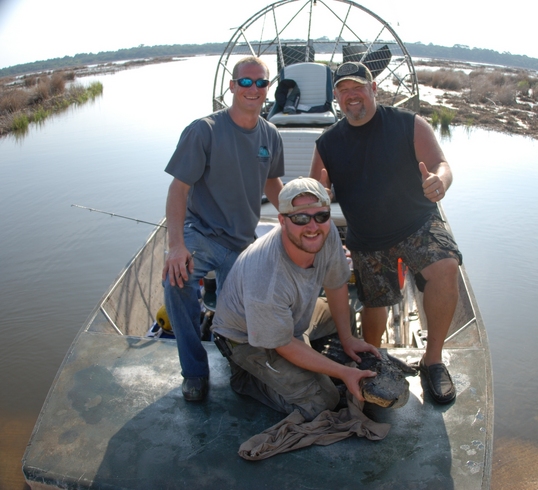FOR IMMEDIATE RELEASE: Jan. 23, 2012
CONTACT: DEP Press Office, (850) 245-2112 or DEPNews@dep.state.fl.us
GUANA TOLOMATO MATANZAS RESERVE’S ALLIGATOR RESEARCH TO BE FEATURED ON NATIONAL TV
~ Only in America with Larry the Cable Guy explores alligator research; episode premieres Jan. 25, 2012 on The History Channel ~
 Larry the Cable Guy after a hard day in the field with Researcher James Nifong (right) and assistant Matt Welsh.
PONTE VEDRA BEACH -- Alligator research underway at Guana Tolomato Matanzas National Estuarine Research Reserve (GTM NERR) will be in the national spotlight in an upcoming segment of Only in America with Larry the Cable Guy, airing on Jan. 25, 2012, on The History Channel. The segment, titled “Extreme American Critters,” features James Nifong, a graduate research fellow, as he shows Larry how to catch, study and release the American alligator. Nifong is a recipient of a grant program managed by the Florida Department of Environmental Protection’s (DEP) Office of Coastal and Aquatic Managed Areas (CAMA), in cooperation with National Oceanic and Atmospheric Administration (NOAA). The program has allowed students to conduct research in GTM’s northeast Florida estuary for 11 years.
“We are thrilled that Larry the Cable Guy is featuring GTM’s research and education programs,” said GTM director Michael Shirley. “Millions of viewers nationwide will have the chance explore science and have fun as they learn more about alligators and their impact on food webs in estuarine systems.”
Larry and a film crew spent the day with Nifong tracking, catching and learning about what alligators eat.
“We do stomach content sampling by pumping the alligator’s stomach. We also take blood and tissue samples, and sometimes add a GPS tag,” said Nifong. “Everything we do with research- even the stomach pumping - allows us to release the alligator alive.”
In 2007, Nifong began a study to assess the use of marine habitats by capturing and bringing alligators into his boat for sampling before releasing them back to the wild. He is studying movement patterns, food habits and ecological interactions in marine and estuarine habitats.
After receiving a B.S. degree in Zoology from the University of Florida, Nifong was awarded a graduate research fellowship from the GTM Research Reserve in 2010. He is currently pursuing his Ph.D. from the University of Florida.
GTM NERR is managed by CAMA and is a part of NOAA’s nationwide network of 28 research reserves. NOAA designated GTM as a National Estuarine Research Reserve in 1999 to promote coastal research, stewardship and education and to promote informed coastal decisions.
|